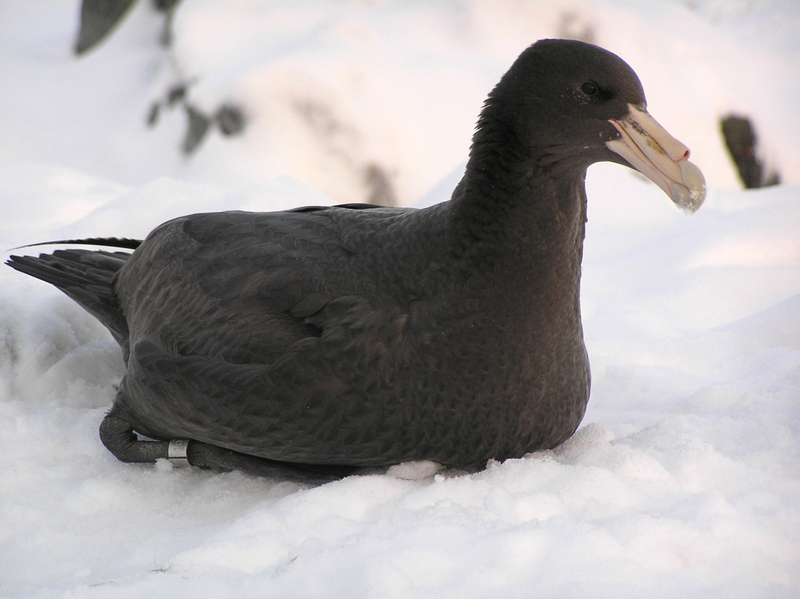|
| 질의: Chordata | 결과: 154번째/224 | |
Petrel (Order: Procellariiformes) - Wiki
| 제목: | Petrel (Order: Procellariiformes) - Wiki
| |

| 해상도: 1201x899
파일크기: 509794 Bytes
촬영일: 0000:00:00 00:00:00
사진기: C765UZ (OLYMPUS CORPORATION)
F number: f/3.2
Exposure: 10/2500 sec
Focal Length: 364/10
등록시간: 2007:12:12 10:35:12
|
Petrel
From Wikipedia, the free encyclopedia
Scientific classification
Kingdom: Animalia
Phylum: Chordata
Class: Aves
Order: Procellariiformes
Families: Procellariidae (true petrels), Hydrobatidae (storm-petrels), Pelecanoididae (diving petrels).
[Photo] Southern Giant Petrel (Macronectes giganteus) chick prior to fledging in early May. Photograph: taken by James Slaughter on May 11, 2005 for the National Science Foundation. URL: U.S. Antarctic Program (http://photolibrary.usap.gov/AntarcticaLibrary/PETRELCHICK.JPG)
Petrels are tube-nosed seabirds in the bird order Procellariiformes. The common name does not indicate relationship beyond that point, as "petrels" occur in three of the four families within that group (except the Albatross family, Diomedeidae). Having a fossil record that was assumed to extend back at least 60 million years, the Procellariiformes was long considered to be among the older bird groupings, other than the ratites, with presumably distant ties to penguins and loons. However, recent research and fossil finds such as Vegavis show that the Galliformes (Pheasants, Grouse and relatives), and Anseriformes (ducks, geese and swans) are older, while the relationships of the tube-nosed seabirds are still not fully resolved.
All the members of the order are exclusively pelagic in distribution ??? returning to land only to breed.
The family Procellariidae is the main radiation of medium-sized true petrels, characterised by united nostrils with medium septum, and a long outer functional primary. It is dominant in the Southern Oceans, but not so in the Northern Hemisphere.
It includes a number of petrel groups, the relationships between which have finally been resolved to satisfaction (Austin, 1996; Bretagnolle et al., 1998; Nunn & Stanley, 1998 and Brooke, 2004):
The fulmarine petrels: 7 species: surface predators and filter feeders, breed in high latitudes but migrate along cool currents to the north. All but Fulmarus essentially confined to the south, Fulmarus apparently colonised the N hemisphere during the Early Miocene.
- The huge giant petrels, genus Macronectes, which are convergent with the albatrosses,
- The true fulmars, genus Fulmarus, (Northern fulmar and Southern fulmar),
- Antarctic Petrel Thalassoica antarctica,
- Cape Petrel Daption capense,
- Snow Petrel Pagodroma nivea.
The prions: A specialised group of a few very numerous species, all southern. They have a small, fulmar-like form and mostly filter-feed on zooplankton.
- Pachyptila, the prions proper
*** Fairy Prion, Pachyptila turtur
*** Slender-billed Prion, Pachyptila belcheri
*** Fulmar Prion, Pachyptila crassirostris
*** Broad-billed Prion, Pachyptila vittata
*** Antarctic Prion, Pachyptila desolata
*** Salvin's Prion, Pachyptila salvin
- Blue Petrel Halobaena caerula.
The procellariine petrels, larger or mid-sized species feeding on fish and molluscs which are fairly close to the prions:
- Procellaria
*** Grey Petrel, Procellaria cinerea
*** White-chinned Petrel, Procellaria aequinoctialis
*** Spectacled Petrel, Procellaria conspicillata
*** Black Petrel, Procellaria parkinsoni
*** Westland Petrel, Procellaria westlandica
- Bulweria.
*** Bulwer's Petrel, Bulweria bulwerii
*** Jouanin's Petrel, Bulweria fallax
Shearwaters: numerous species in several genera with a medium number of species.
- Calonectris,
*** Streaked Shearwater, Calonectris leucomelas
*** Cory's Shearwater, Calonectris diomedea
*** Cape Verde Shearwater, Calonectris edwardsii
- Puffinus, which is in fact two rather distinct groups of larger and smaller species,
- Pseudobulweria,
*** Fiji Petrel, Pseudobulweria macgillivrayi
*** Tahiti Petrel, Pseudobulweria rostrata
*** Beck's Petrel, Pseudobulweria becki
*** Mascarene Petrel, Pseudobulweria aterrima
*** St Helena Petrel, Pseudobulweria rupinarum
- Kerguelen Petrel Lugensa brevirostris.
The gadfly petrels: These are a considerable number of agile short-billed petrels in the genus Pterodroma which include the endangered Bermuda Petrel or Cahow and a considerable number of forms rendered extinct by human activity.
The family Hydrobatidae is the storm-petrels, small pelagic petrels with a fluttering flight which often follow ships.
The family Pelecanoididae is the four species of diving petrels, genus Pelacanoides. These are auk-like small petrels of the southern oceans.
Etymology
The word "petrel" comes from the Latin name for the Christian Saint Peter, and refers to the habits of certain species to hover just above the ocean waves, with their feet barely touching the water, thus giving an appearance of walking on water, as St. Peter is said to have done.
http://en.wikipedia.org/wiki/Petrel
| The text in this page is based on the copyrighted Wikipedia article shown in above URL. It is used under the GNU Free Documentation License. You may redistribute it, verbatim or modified, providing that you comply with the terms of the GFDL. |
|
댓글 |
|---|
| | 손님 |
|
petrel
Main Entry: pe·trel
Pronunciation: \??pe-tr??l, ??p??-\
Plural: petrels
Function: noun
Etymology: alteration of earlier pitteral
Date: 1676
: any of numerous seabirds (especially families Procellariidae and Hydrobatidae); especially : one of the smaller long-winged birds that fly far from land |
^o^
동물그림창고 똑똑전화 누리집
^o^
|
|
|

